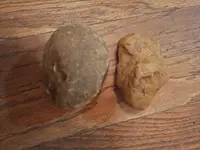How do you know how to tell a hammer stone from just a nice round rock? I ask because if I saw that hammer stone on the ground, I'd probably not realize it was an artifact of any kind. What are the things to look for?
I like your question because it is so genuine and real. Many people don’t ask these questions because they are afraid it makes them a noob but reality shows that many experienced folks often struggle with this at times.
Here’s one clue: context and surroundings
Where did you find it? What was surrounding it? Was the area that you located the potential Hammerstone a Native American area? did you find it randomly in a field where it looked completely out of place? Or did you find it lying on a road and it looked roughed up and you thought, is that a hammer stone? Context means so much when you’re looking at this type of artifact.
I spent the past two weeks touring Mayan ruins in Guatemala and Belize. Some old areas, and some new areas that are still being excavated or found. We were amazed at how little Debitage was noted in areas that we expected to see tons of it. but surprisingly, we were not initially seeing a great deal of evidence. Even in the areas that were used as quarrys to obtain the granite for the various buildings, there was very little debris. Those same areas were often filled with water, coated/painted, and used as water storage and Wells. We began to think that the Mayans were pretty damn good housekeepers. But then, on the very outskirts of all of the ruins, temples, living areas, etc. over the far hillsides. We started finding all kinds of artifacts, flakes, flint, Chert, and… hammerstones everywhere. Everywhere. Broken and abused. Literally tripping over hammerstones. Let’s face it, those ruins didn’t build themselves, and they took a lot of hard work. we were overjoyed to find all of the hammer stones finally.
So if you find an area that was common native American Indians. Say an area that has a great deal of Flint or other material that was commonly used by tribes. Near rock shelters where they worked on items that they would need for day-to-day life. You just watch these areas closely and see what you can find. If you find something that resembles, or remind you that it might be a hammer stone and it fits in with the surroundings, then you might be on something. Once you start to find some of these items And get a good view at them and how they appear, it sure helps you find an identify them another area.






